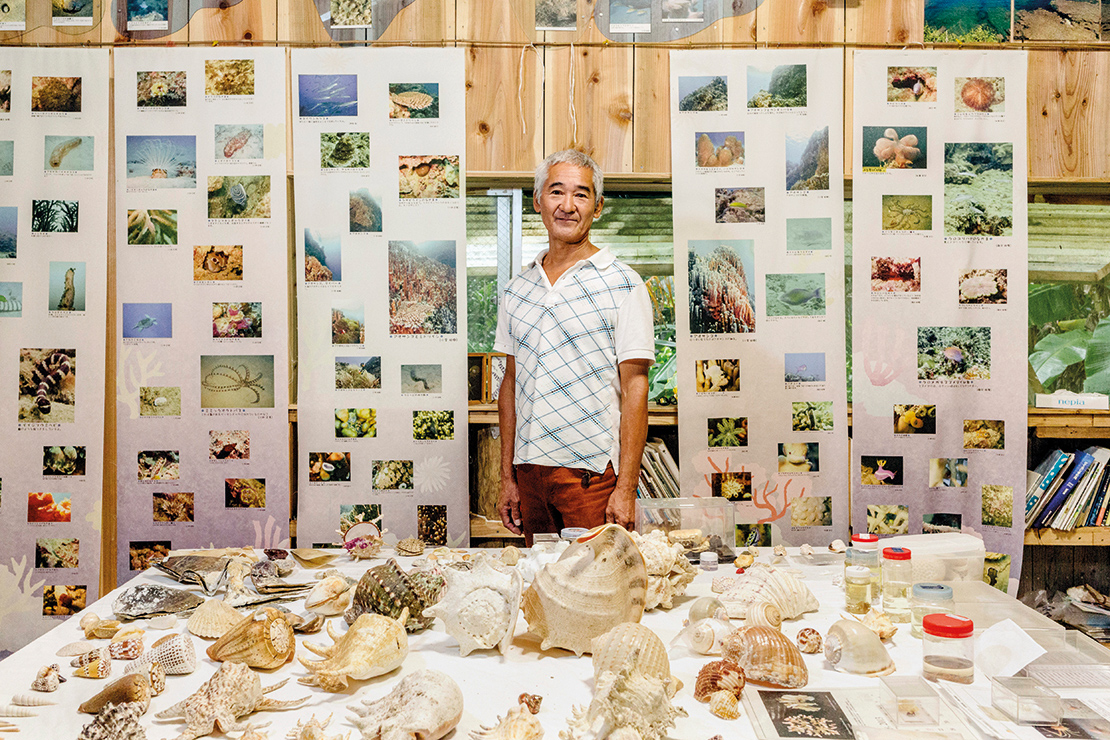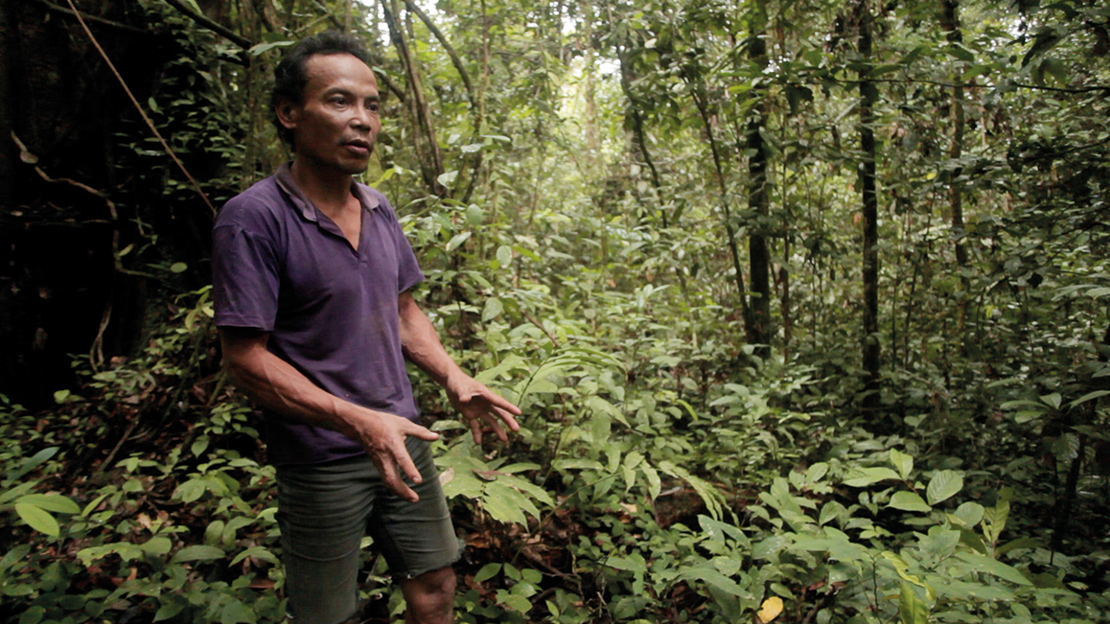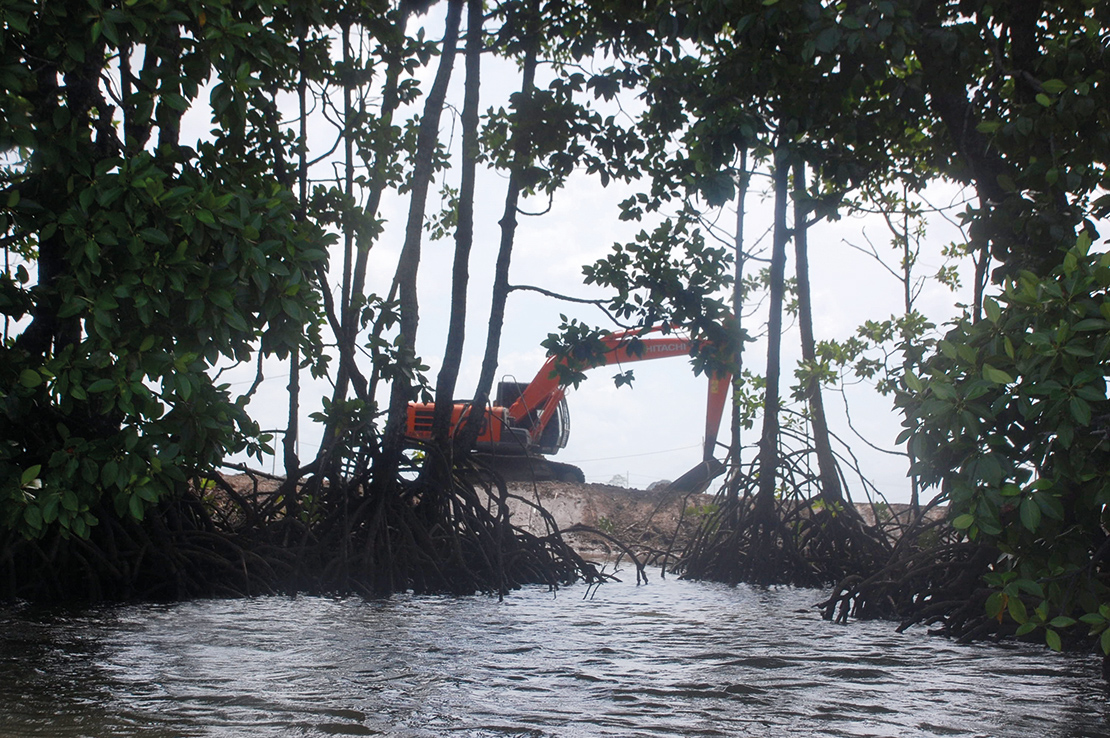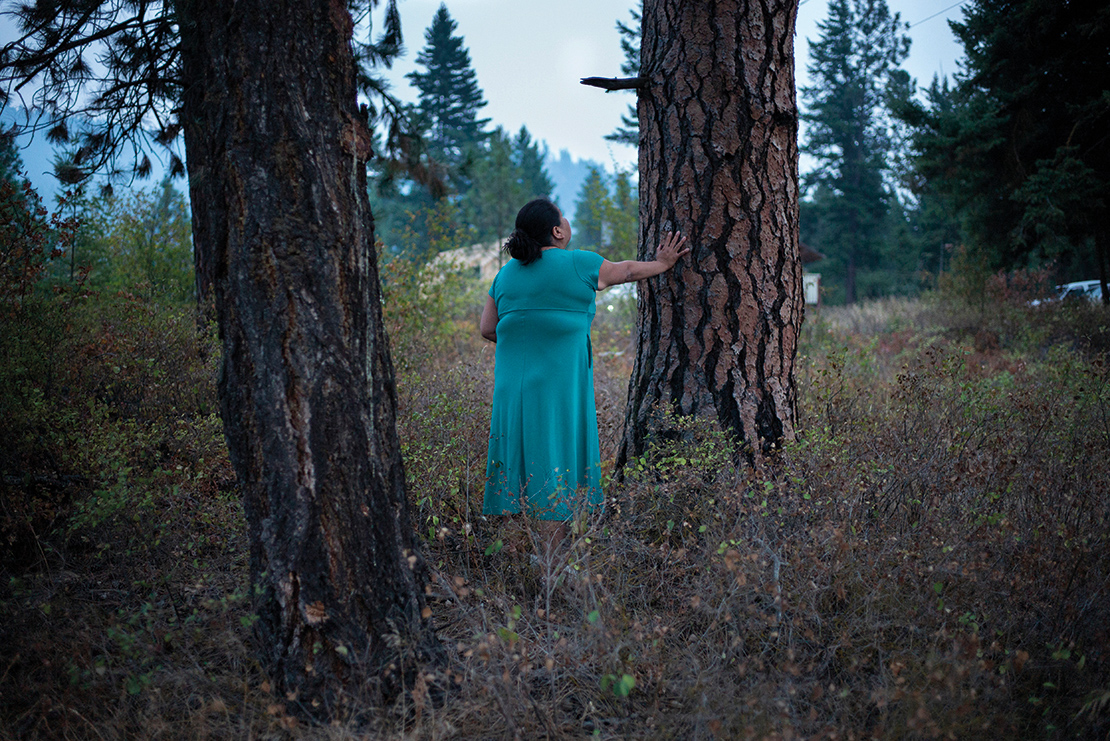
Target 5: Habitat loss halved or reduced
By 2020, the rate of loss of all natural habitats, including forests, is at least halved and where feasible brought close to zero, and degradation and fragmentation is significantly reduced.
Key messages
- Natural habitats are declining at an alarming and unprecedented rate, but there is evidence that they are declining less rapidly in the lands and territories of indigenous peoples than elsewhere.
- Nonetheless, the lands and territories of indigenous peoples and local communities (IPLCs) and the associated habitats are under widespread threat from industrial-scale incursions.
- IPLCs who are countering these threats are facing increasing violence, intimidation and criminalisation.
- To address Target 5, universal recognition and support for IPLC rights, acceleration of titling of their lands and waters, and zero tolerance for persecution of environmental human rights defenders are essential.
“Our community leaders are putting their lives at risk to defend our world.”
— Geovaldis González Jiménez, community defender, Colombia
Significance of Target 5 for IPLCs
Land-use change, and the subsequent loss of natural habitats, is not only the most important cause of biodiversity loss across the world1 but also has a disproportionate effect on IPLC livelihoods, cultures and wellbeing. The problems have been recognised for many decades, yet forests and other habitats continue to be destroyed and degraded at an alarming and unprecedented rate.2Decision-making dominated by elites and powerful vested interests is often linked to systemic corruption and distortions of democratic rule, with large parts of society left behind.
Many IPLCs are fighting back against habitat destruction and working to defend their lands and territories, but are finding increasingly that, rather than receiving support for their actions, they face violence, intimidation and criminalisation. In these situations, they are often powerless to stop forests and other natural habitats from being destroyed as large-scale agriculture3 and the extractive industries expand onto their lands.4

A member of a local diving team in Okinawa, Japan. The diving team monitors Oura Bay and documents what will be lost with the building of a proposed US military airstrip. Credit: Ian Teh.
Contributions and experiences of IPLCs towards Target 5
Indigenous peoples are estimated to own and manage over a quarter of the world’s land area,5 and 36 per cent of intact forest landscapes reside within their lands and territories.6 When the social, legal and economic conditions enable them to do so, IPLCs are highly effective at preventing the loss of natural habitats: comparative studies have shown that territorial management and conservation have been at least as effective at halting forest loss as government protected areas.7
In many cases, IPLCs act as environmental stewards. For example:
- The Kayapo people in Amazonian Brazil have conserved 105,000 square kilometres of forests in a frontier otherwise characterised by heavy deforestation due to agricultural expansion, logging and illegal gold mining.8
- The Wampis people in Peru have formed a collective self-governing body which takes peaceful direct action to remove illegal miners and land-grabbers.9 Similarly, in the Resguardo Cañamomo Lomaprieta in Colombia, indigenous communities have established a guard to patrol and monitor their lands, removing illegal miners.10
However, many IPLCs working to defend their lands and ways of life are facing increasing levels of violence, intimidation and criminalisation, an issue recognised by the UN Human Rights Council in March 2019.11 Although statistics are hard to come by due to a lack of systematic reporting, important investigations by Global Witness, the Business & Human Rights Resource Centre, Front Line Defenders, various UN special rapporteurs and others all point to a rising tide of criminalisation and assault:
- Victoria Tauli-Corpuz, the UN Special Rapporteur on the rights of indigenous peoples, highlighted in her 2017 report to the UN Human Rights Council that indigenous peoples have been subjected to a spectrum of abuse including attacks, stigmatisation, forced displacement, criminalisation, and threats.12 She herself was placed on a terrorist list by the government of the Philippines in February 2018 after speaking out against the administration’s human rights violations.
- In 2018, Front Line Defenders found that 77 per cent of the human rights defenders killed in 2018 were defending land, indigenous rights or the environment. Research by the same organisation in 2019 continued to show that those working in defence of land rights are disproportionately represented in the statistics of killings, and that 85 per cent of those killed had previously been threatened either individually or as part of the community or group in which they worked.13
- In 2018, Global Witness also noted that businesses that relied heavily on the use of natural resources were most implicated in the killings of environmental human rights defenders. The extractive industries were the deadliest sector, followed by agribusiness, water projects and dams, and logging.14
- Similarly, the UN Special Rapporteur on the situation of human rights defenders noted in his 2016 report on environmental human rights defenders15, that the commodification of the environment is a driver of social and environmental conflict, meaning that increasing intensification of competition for natural resources could lead to worse outcomes for defenders.
- Apart from killings and other direct physical attacks, environmental human rights defenders are also subject to threats, intimidation and smear campaigns; arrest and legal action; and disappearance.16 The Business & Human Rights Resource Centre has documented more than 2,000 such attacks on human rights defenders raising concerns about business-related human rights abuses since 2015, with mining and agribusiness being the most dangerous sectors.17
Clearly, this rise in criminalisation and assault has created a climate of fear and insecurity in many communities, where the strongest allies in fighting biodiversity loss are most at risk of attack. It has created severe environmental conflicts and heightened calls for environmental justice.18
In Latin America and the Caribbean (LAC), where the highest numbers of killings are taking place, an important step towards addressing the issues is the opening for signature of the Escazu Agreement (the regional agreement on access to information, public participation and environmental justice in Latin America and the Caribbean).19 The Escazu Agreement is the first environmental human rights treaty in the region. So far, it has been ratified by eight LAC countries, and it will come into force when 11 ratifications are submitted. Its implementation is currently being piloted and there are hopes it will come into force later this year. However, much greater action is needed to address these conflicts. Situations such as those described in Box 8 and Box 9 undermine the ability of IPLCs to effectively manage their lands and territories, and this, in turn, accelerates the loss of habitats and biodiversity.
Box 8: Dayak Bahau Busaang community of Long Isun and Forest Peoples Programme
A man explaining the use of plants for medicine in Long Isun, Indonesia. Credit: Angus MacInnes.

Case study: Criminalisation of a Dayak community in Long Isun, East Kalimantan, Indonesia
“Dayaks can’t be separated from the forest; our lives are spent in the forest. Without her we lose our identity.”
— Inui Yeq, spiritual leader, Long Isun
So-called responsible logging, which has been brought into the community as part of a larger transnational conservation project – ‘The Heart of Borneo’ – has caused serious conflict between Long Isun and a neighbouring community, Naha Aruq. This is primarily thanks to a flawed participatory mapping process carried out for the conservation project by The Nature Conservancy.
— Read the full case study
Box 9: Mastupang Somoi, Jawatankuasa bio Komuniti Gabungan 6 kampung and Lanash Thanda, Sabah Environmental Protection Association
Mangroves being destroyed for shrimp farming in Sabah, Malaysia. Credit: Alice Mathew.

Case study: Communities fight to protect mangroves in Pitas, Sabah, Malaysia
The villages around the Telaga River in Pitas, Sabah, Malaysia, depend on the local mangroves for their livelihoods, through farming, fishing and foraging. However, their way of life has been threatened by a shrimp aquaculture project that is being promoted by the Malaysian Government, allegedly to reduce poverty in the area.
— Read the full case study
IPLCs have also been working at the policy level to prevent the loss of natural habitats:
- In 2014, indigenous peoples joined with governments, multilateral institutions, companies and civil society to release the New York Declaration on Forests which seeks to “strive to halve deforestation by 2020 and to end it by 2030.”
- In a related initiative, also in 2014, a global coalition of indigenous peoples pledged to protect 400 million hectares of forests.20
- IPLCs worked hard to get the CBD’s Plan of Action on Customary Sustainable Use21 passed in 2014, and have continued to engage with its implementation at the local level across the globe.22
- In 2014, a group of IPLCs and supportive NGOs gathered to develop the Palangka Raya Declaration on Deforestation and the Rights of Forest Peoples, which calls for urgent action to address rights violations and to secure the world’s forests.23
- At the sectoral level, IPLC representatives are working with the Roundtable on Sustainable Palm Oil to promote a mosaic land-use approach for palm oil, including zones where community landowners can grow oil palms, but also zones with multiple uses, including small-scale agriculture and conservation areas for protecting high carbon-stock forests and high conservation values.
- In 2019, indigenous peoples’ organisations launched the ‘Global Initiative to Address and Prevent Criminalization and Impunity against Indigenous Peoples’, spearheaded by the UN Special Rapporteur on the rights of indigenous peoples “to prevent, respond, reduce and prevent acts of criminalization and impunity against indigenous peoples and to provide better protection and access to justice for actual and potential victims not only as individuals but as collectives or communities.”
- At the 2019 UN Forum on Business and Human Rights, indigenous peoples’ representatives, community leaders and supportive organisations launched the ‘Zero Tolerance Initiative’, calling for businesses to take a leading role in addressing violence and threats linked to global supply chains.
“If we are going to save the planet, we have to stop killing and criminalising the people who protect it.”
— Victoria Tauli-Corpuz, former UN Special Rapporteur on the rights of indigenous peoples

A woman carries out an offering ceremony at the Tiny House Warriors’ camp. The Tiny House Warriors are a group of activists who constructed a series of homes in the path of the Trans Mountain oil sands pipeline development. Credit: Ian Willims.
Opportunities and recommended actions
- Governments and all relevant actors should support IPLCs who protect their lands, territories and resources, and the biodiversity within them, from external forces that cause biological and cultural diversity loss.
- Governments should commit to providing a safe and enabling environment in which environmental defenders—with particular attention to indigenous peoples, local communities and women—can operate free from threats, harassment, intimidation and violence.24
- The United Nations Secretary-General, Human Rights Council special procedure mandate-holders, the UN Office of the High Commissioner for Human Rights, other global and regional rights-related institutions, and governments should harmonise across international environmental and human rights conventions to: respect, protect and fulfil the rights of environmental human rights defenders; support prevention and protection measures; and strengthen the independence of investigative and judicial bodies.
- Governments and donors should commit to expanding the extent of IPLC lands and resources under secure tenure, including through: national legislation related to land rights; new forest tenure funds accessible to communities; new incentive mechanisms; and monitoring and reporting based on appropriate indicators.
- Governments should support the contributions of IPLCs to Target 5 and to related key processes, including but not limited to the Sustainable Development Goals (particularly SDG 15), the CBD Plan of Action on Customary Sustainable Use of Biological Diversity, the UN Environment Programme’s resolution on innovation on biodiversity and land degradation (UNEP/EA.4/Res.10), and climate change processes.25
- The private sector and conservation NGOs must commit to zero tolerance of human rights violations linked in any way to their work, and implement policies and procedures that actualise those commitments.
Key resources
- Martone, F. (2019) Enough! Pledging zero tolerance to attacks against environmental and human rights defenders. Moreton-in-Marsh: Forest Peoples Programme. Available at: https://www.forestpeoples.org/en/lands-forests-territories/report/2019/enough-pledging-zero-tolerance-attacks-against-environmental
- Global Witness (2019) Enemies of the state? How governments and businesses silence land and environmental defenders. London: Global Witness. Available at: https://www.globalwitness.org/en/campaigns/environmental-activists/enemies-state/
- Fa, J.E. et al. (2020) ‘Importance of indigenous peoples’ lands for the conservation of intact forest landscapes’, Frontiers in Ecology and the Environment 18(3).
References
- Hansen A.J., DeFries R.S. and Turner W. (2012) ‘Land use change and biodiversity’. In: Gutman G. et al. (Editors) Land change science: Remote sensing and digital image processing, volume 6. Dordrecht: Springer.
- Watson, J.E.M., Evans, T., Venter, O. et al. (2018) ‘The exceptional value of intact forest ecosystems’, Nature Ecology & Evolution 2, pp. 599–610.
—
Horváth, Z., Ptacnik, R., Vad, C. F. and Chase, J. M. (2019) ‘Habitat loss over six decades accelerates regional and local biodiversity loss via changing landscape connectance’, Ecology Letters 22(6).
—
Curtis, P. G., Slay, C. M., Harris, N. L., Tyukavina, A. and Hansen, M. C. (2018) ‘Classifying drivers of global forest loss’, Science 361 (6407), pp. 1108-1111.
—
IPBES (2019) ‘Nature’s dangerous decline “unprecedented”; Species extinction rates “accelerating”’. Media Release. Accessed 6 November 2019: https://www.ipbes.net/news/Media-Release-Global-Assessment#2-Indigenous - Commercial agriculture is estimated to be the proximate driver for 80 per cent of deforestation worldwide. Source: Hosonuma, N., Herold, M., de Sy, V., de Fries, R.S., Brockhaus, M., Verchot, L., Angelsen, A., Romijn, E. (2012) ‘An assessment of deforestation and forest degradation drivers in developing countries’, Environmental Research Letters 7(4).
- IPBES (2019) Summary for policymakers of the global assessment on biodiversity and ecosystem services of the Intergovernmental Science-Policy Platform on Biodiversity and Ecosystem Services. S. Díaz, J. Settele, E. S. Brondízio E.S., H. T. Ngo, M. Guèze, J. Agard, A. Arneth, P. Balvanera, K. A. Brauman, S. H. M. Butchart, K. M. A. Chan, L. A. Garibaldi, K. Ichii, J. Liu, S. M. Subramanian, G. F. Midgley, P. Miloslavich, Z. Molnár, D. Obura, A. Pfaff, S. Polasky, A. Purvis, J. Razzaque, B. Reyers, R. Roy Chowdhury, Y. J. Shin, I. J. Visseren-Hamakers, K. J. Willis, and C. N. Zayas (eds.). Bonn, Germany: IPBES. Available at: https://doi.org/10.5281/zenodo.3553579
- At present, there are no clear data on the lands of non-indigenous local communities.
Garnett, S. T. et al. (2018) ‘A spatial overview of the global importance of Indigenous lands for conservation’, Nature Sustainability 1(7), pp. 369–374. - Fa, J.E. et al. (2020) ‘Importance of Indigenous Peoples’ lands for the conservation of intact forest landscapes’, Frontiers in Ecology and the Environment 18(3).
- Sobrevila, C. (2008) The role of indigenous peoples in biodiversity conservation: The natural but often forgotten partners. Washington D.C.: World Bank. Available at: http://siteresources.worldbank.org/INTBIODIVERSITY/Resources/RoleofIndigenousPeoplesinBiodiversityConservation.pdf.
—
Schleicher, J., Peres, C.A., Amano, T. et al. (2017) ‘Conservation performance of different conservation governance regimes in the Peruvian Amazon’, Sci Rep 7, 11318.
—
Fa, J.E. et al. (2020) ‘Importance of Indigenous Peoples’ lands for the conservation of intact forest landscapes’, Frontiers in Ecology and the Environment 18(3). - Peng, J. (2015) ‘Unconquered Kayapó warriors fighting for their Amazon land’. DW. Bonn: Deutsche Welle. Available at: https://www.dw.com/en/global-ideas-brazil-native-agriculture-pec215/a-18729288
- Wampis Nation (2015) Statute of the Autonomous Territorial Government of the Wampis Nation. Irutkamu Soledad: Wampis Nation. Available at: https://www.un.org/development/desa/indigenouspeoples/wp-content/uploads/sites/19/2018/01/STATUTE-OF-THE-AUTONOMOUS-TERRITORIAL-GOVERNMENT-OF-THE-WAMPIS-NATION-ENGLISH-ABRIDGED-1.pdf
- For more details on the Resguardo Cañamomo Lomaprieta, see Target 15.
- International Network for Economic, Social & Cultural Rights (2019) UN resolution recognizes environmental defenders. New York: International Network for Economic, Social & Cultural Rights. Available at: https://www.escr-net.org/news/2019/un-resolution-recognizes-environmental-defenders
- United Nations General Assembly (2018) Report of the Special Rapporteur on the rights of indigenous peoples: Note by the Secretariat. A/HRC/39/17. Available at: https://www.undocs.org/A/HRC/39/17
- Front Line Defenders (2020) Front Line Defenders Global Analysis 2019. Dublin: Front Line, the International Foundation for the Protection of Human Rights Defenders. Available at: https://www.frontlinedefenders.org/en/resource-publication/global-analysis-2019
- Global Witness (2019) Enemies of the state? How governments and businesses silence land and environmental defenders. Report. London: Global Witness. Available at: https://www.globalwitness.org/en/campaigns/environmental-activists/enemies-state/
- Forst, M. (2016) Report of the Special Rapporteur on the situation of human rights defenders A/71/281. New York: United Nations General Assembly. Available at: https://www.ohchr.org/EN/Issues/SRHRDefenders/Pages/AnnualReports.aspx
- Trócaire (2019) Making a killing: Holding corporations to account for land and human rights violations. Report. Dublin: Trócaire. Available at: https://www.trocaire.org/sites/default/files/resources/policy/making_a_killing_holding_corporations_to_account_for_land_and_human_rights_violations_1.pdf
—
Martone, F. (2019) Enough! Pledging zero tolerance to attacks against environmental and human rights defenders. Moreton-in-Marsh: Forest Peoples Programme. Available at: https://www.forestpeoples.org/en/lands-forests-territories/report/2019/enough-pledging-zero-tolerance-attacks-against-environmental - Business & Human Rights Resource Centre (2020) ‘Human Rights Defenders & Business January 2020 Snapshot.’ London: Business & Human Rights Resource Centre. Available at: https://dispatches.business-humanrights.org/hrd-january-2020/index.html
- The Ecologist (2020) ‘Environmental conflicts and defenders.’ Bideford: The Ecologist. Available at: https://theecologist.org/2020/jun/02/environmental-conflicts-and-defenders
- Convention on Biological Diversity (2019) Report from the Preparatory Workshop ‘Integrated Local Approaches to Ecosystems Restoration Governance.’ Montreal: Convention on Biological Diversity. Available at: https://4post2020bd.net/wp-content/uploads/2019/11/Feedback-preparatory-workshop-restoration.pdf
- Lima Paris Action Agenda (2015) Partnerships, progress to protect & restore forest: Global leaders from governments, private sector, civil society and indigenous peoples join to address pressing issues. Lima Paris Action Agenda. Available at: https://unfccc.int/sites/default/files/lpaa-forest-focus-press-release-20150112.pdf
—
UN Climate Change (2015) ‘Protection of 400 million hectares of Forests by Indigenous Peoples’. Bonn: UN Climate Change. Available at: https://unfccc.int/news/protection-of-400-million-hectares-of-forests-by-indigenous-peoples - United Nations Environment Programme and the Convention on Biological Diversity (n.d.) Plan of Action on Customary Sustainable Use and Biological Diversity. UNEP/CBD/COP/DEC/XII/12, B, Annex. Montreal: Convention on Biological Diversity. Available at: https://www.cbd.int/doc/publications/cbd-csu-en.pdf
- Forest Peoples Programme, Secretariat of the Convention on Biological Diversity and International Indigenous Forum on Biodiversity (2016) Local Biodiversity Outlooks: indigenous peoples’ and local communities’ contributions to the implementation of the Strategic Plan for Biodiversity 2011-2020. Moreton-in-Marsh: Forest Peoples Programme. Available at: http://www.forestpeoples.org/en/convention-biological-diversity-cbd-cultural-identity/report/2016/local-biodiversity-outlooks
- Various (2014) The Palangka Raya Declaration on Deforestation and the Rights of Forest Peoples. Moreton-in-Marsh: Forest Peoples Programme. Available at: https://www.forestpeoples.org/sites/fpp/files/private/news/2014/03/Declaration%20-%20English.pdf
- Forest Peoples Programme (2020) ‘Including human rights in the post-2020 Global Biodiversity Framework’. Moreton-in-Marsh: Forest Peoples Programme. Available at: http://www.forestpeoples.org/en/post2020-Global-Biodiversity-Framework
- United Nations Environment Programme (2019) Resolution adopted by the United Nations Environment Assembly on 15 March 2019, UNEP/EA.4/Res.10. United Nations Environment Programme. Available at: https://undocs.org/UNEP/EA.4/Res.10


